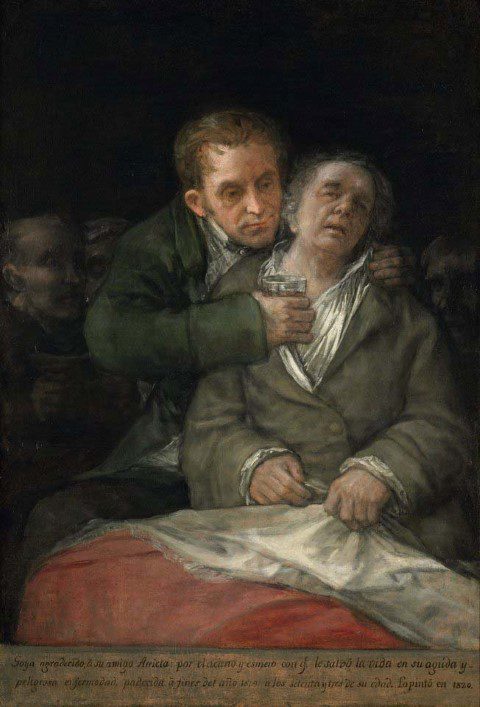 |
| Self Portrait with Dr. Arrieta Francisco de Goya, 1820 |
William Stringer
Los Angeles, California, United States
Francisco Goya (1746-1828) was a deaf Spanish painter who almost died of a severe, unknown illness in 1819.1 He painted this self-portrait in 1820 to illustrate the kind and attentive care provided by Dr. Arrieta.2 In Goya’s younger years as a court painter, he created light and airy scenes of rich and famous aristocracy in fancy dresses and children with colorful parasols.3 As he aged, he abruptly became deaf and suffered a number of nervous breakdowns with clinical depressive episodes that resulted in the creation of the Pinturas Negras (Black Paintings) on the walls of the Quinta del Sordo (Villa of the Deaf).4 His views on the true nature of human beings, which appears to have morphed during his lifetime, were definitively documented at his Quinta del Sordo residence in the last years of his life.
Goya was one of the first painters to portray the ever-present defects in human beings with his drawings and paintings, choosing this darker portrayal over the more noble and praiseworthy side of humanity. These defects could be physical (illness, disease, abnormal stature, grotesque faces, amputation, and other deformities), mental (insanity, obsession, and insane asylums), or social (poverty, war, hunger, religious persecution). Goya had a unique eye for art that might cast light on society’s ills and perhaps improve life for the common person.
In the portrait, Dr. Arietta, with his hand on Goya’s shoulder and supporting him to sit up in bed, is offering a glass of a dark liquid (perhaps with some medicinal properties) to a very pale, ill looking, apathetic, downtrodden Goya. Several ill-formed and macabre figures lurk behind Goya. Dr. Arrieta seems to be protecting Goya from being taken away by these evil spirits/illnesses. Goya barely holds onto life (and the coverslip of the bed). Arrieta is portrayed as confident, in charge, skilled, and competent to restore Goya to health.
Goya often used pathos to appeal to the emotions of his audience and displayed a great deal of empathy for the poorer souls around him in the eighteenth and nineteenth century. Perhaps Goya’s highest tribute to Dr Arrieta was to illustrate him as possessing similar empathic qualities. Goya could indeed be quite harsh in his portrayals of the flaws of others, but it appears that Goya genuinely appreciated the care provided by Dr. Arrieta. Goya would recover, live, and work another eight years,5 the period when he finished some of his most unsettling and otherworldly works, the Pintas Negras on the walls of the Quinta del Sordo (1819-1823).
References
- Tomlinson, J. “Francisco Goya y Lucientes. 1746-1828. “ Phaidon Press, Ltd. London, England 1994.
- Self Portrait with Dr. Arrieta. https://collections.artsmia.org/?page=simple&id=1226#. The caption reads: “Goya gives thanks to his friend Arrieta for the expert care with which he saved his life from an acute and dangerous illness which he suffered at the close of the year 1819 when he was seventy-three years old. He painted it in 1820.” The original hangs in the Minneapolis Institute of Art, Gallery G321.
- Francisco Goya. Wikipedia: http://en.wikipedia.org/wiki/Goya
- The Black Paintings of Francisco Goya. Wikipedia: http://en.wikipedia.org/wiki/Black_Paintings#The_Black_Paintings_in_their_original_setting
- Wolfenstein, M. “Goya’s Dining Room.” Psychoanalytic Quarterly, 35, 47-83, 1966a.
WILLIAM W. STRINGER, MD, FACP, FCCP, is a pulmonary and critical care physician and a professor of medicine at the Geffen School of Medicine at UCLA (University of California, Los Angeles). Dr Stringer is interested in the relationship between the humanities and medicine, especially art and music. He has given talks about various topics in the history of medicine, including “The Art of Medicine,” where he explores the intersection of art with medicine throughout recorded human history. He is especially taken with the collective works of Francisco Goya, and a copy of the El Gran Cabrón/Aquelarre from the Black Paintings hangs in his office.
Summer 2014 | Sections | Art Flashes

Leave a Reply